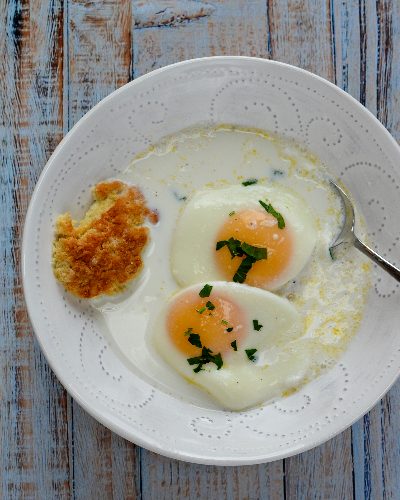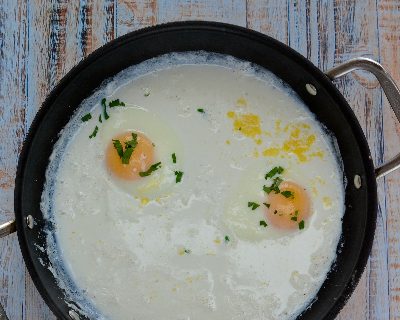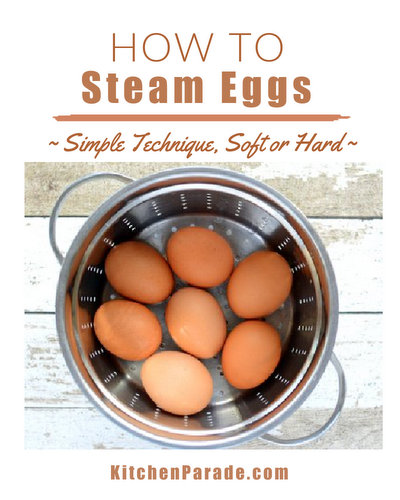| Eggs Poached in Milk |  |
Whole Food, Simply Prepared, "Plain" But Perfect. Comfort Food When Someone's Sick. Mere Minutes to the Table. Budget Friendly. Perfect When Cooking for One or Two. Vegetarian.
~ PIN This Recipe ~
COMPLIMENTS!
- "That was perfect. Tomorrow too, please?" ~ my sweet husband, the third morning
Who'd have guessed that three years in — no, almost four, my sister corrects me — that so many people are getting sick?
Since Thanksgiving, it seems, every day word arrives that someone else is down with a bad cold, a sinus infection, strep, the flu, RSV and of course, Covid. We cancelled our big extended family Christmas gathering (last held in 2019) once three separate family units had tested positive for Covid. No way, after all this time, were we going to host a super-spreader event!
So these past weeks, my nursing skills have been put to the test, nothing hard, really, just exercising out-of-practice caretaker muscles.
One thing I got right? Comfort food, especially this simple breakfast (or afternoon sustenance or midnight snack or ...), a way of poaching eggs in milk instead of water, something my mom used to make way back when after ginger ale and soft jello no longer sufficed for upset stomachs.
What, Exactly, Is "Poaching" Again?
LOL, we'll focus on poached eggs here, not trespassing to hunt on someone else's property.
"Poach" is culinary shorthand for the cooking technique that cooks a food in a simmering liquid.
If you've ordered Eggs Benedict at a restaurant? Those eggs were likely poached, the whites firm but not tough, the yolks hot and runny. So good, right?
Poached eggs are probably the most common food cooked this way but the method is also used for chicken breasts, fish, asparagus, pears and more. For example, I poach chicken breasts to make Lemon Chive Chicken Salad because poaching yields such moist, tender meat.
Water is the most common liquid for poaching but other liquids work too, maybe chicken stock or fish stock or vegetable stock, maybe a fruit juice or wine for fruit.
What's the difference between poaching and boiling? Temperature. And just a few degrees, controlled by the stove temperature.
- When a food is boiled, the liquid has reached the boiling point, big bubbles pop through the liquid's surface.
- When a food is poached, the liquid remains just below the boiling point, forming small bubbles on the edges, maybe a few soft bubbles reaching the surface.
Poaching is a gentler cooking method than boiling. To avoid boiling, just turn down the temperature a bit, adjust it up and down to keep the food poaching not boiling.
About This Recipe: Eggs Poached in Milk
- Eggs are usually poached immersed in a pot of simmering salted water. Instead, here a few eggs are poached in a shallow skillet of simmering salted, buttery milk. Once poached, the eggs are served over soft bread that soaks up the delicious, slightly sweet, slightly thickened milky broth.
- Kitchen Tools = a large non-stick skillet + a spatula + a spoon
- Short Ingredient List = Whole Milk + Eggs + Salt + Butter plus some sort of soft bread for serving
- For Garnish, Optional = chopped herbs + extra butter
- Eggs cooked in this recipe are "poached". Poaching is a distinct cooking technique, food cooked in a liquid that's kept at a bare simmer, never allowed to boil.
- It takes about 15 minutes to poach eggs in milk, most of it is hands-on but there is time available to prep the serving bowls, make some toast, etc.
- Eggs poached in water emerge as amorphous blobs, the yolks hidden inside. Instead here, eggs poached in milk look almost as if they've been fried sunny-side up, the pretty golden yolks surrounded by firm, opaque egg whites.
- It takes a large skillet to poach even a few eggs in milk. For example, I use a 12-inch skillet, this Cuisinart non-stick skillet (affiliate link) that is my number one skillet. (A lid is not used for poaching eggs but I love that this skillet comes with a glass lid!) It's big enough for cooking as many as four eggs at time.
- This means that this recipe is best suited for serving one or two people.
- Eggs Poached in Milk should be served hot straight out of the pan while the eggs and cooking liquid are still hot, otherwise, well, it's all just cold, unappealing eggs in tepid milk.
- This is a budget-friendly recipe made with ingredients often kept on hand.
- This recipe works especially well for those Cooking for One or Two.
- So good! I hope you love it!
- Out of milk? Consider the traditional way to poach eggs in water using Cook's Illustrated's step-by-step technique, see How to Poach a Perfect Egg.
- Not quite what you're looking for? Check out my other egg recipes.
What Makes This Recipe Special
- ... easy on a tummy that's upset or sore.
- ... provides nourishment for someone who doesn't feel well or doesn't really feel up to eating.
- ... supplies plenty of calories with little food volume and little effort to eat.
- ... the eggs are soft and comforting, easily eaten with a spoon.
- Ready to get started? Here's your recipe!
Bookmark! PIN! Share!
How do you save and share favorite recipes? recipes that fit your personal cooking style? a particular recipe your mom or daughter or best friend would just love? If this recipe inspires you, please do save and share! I'd be honored ...
~ PIN This Recipe ~
EGGS POACHED IN MILK
Time-to-table: 15 minutes
Makes up to four poached eggs in a large skillet
- Whole milk, preferably
- Salt, be generous
- Butter for extra richness, optional
- Eggs
-
TO SERVE
- A shallow bowl, warmed with hot water
- Toast or a biscuit half or a soft roll, torn up if helpful
- Poached Eggs
- Butter, optional
- Hot Milk
- Fresh herbs, optional
- Finishing salt such as fleur de sel, Maldon, etc.
HEAT THE MILK Place a large non-stick skillet on the stove, set the heat to medium high. While the skillet is still warming up, pour in enough milk about 1/4-inch thick; just eyeball it, the idea is to not cover the eggs but to have enough to ladle over the their tops as they poach. (In my 12-inch skillet, 2 cups works out well for 3 eggs.) Sprinkle salt over top, stir in with a spatula. As the skillet warms, use the spatula to gently scrape the bottom of the skillet, this avoids scalding the milk and distributes the heat throughout the milk. If at any time the scrapings are tan in color, the skillet is too hot, turn down the heat.
Heating the milk will take several minutes, scrape the bottom often but you'll have time to warm a bowl or two, make some toast, get out the butter, chop up a few herbs, etc. The milk is "ready" when milk bubbles begin to form on the edges of the skillet but before the milk begins to boil. Turn the heat down to medium.
If helpful for someone who may need some extra calories, add a tablespoon or two of butter to the milk.
POACH THE EGGS Carefully slip the eggs into the hot milk, each in their own distinct position, leaving room between. Use the tip of the spatula held upright to gently center the still-gloppy egg whites around their yolks. Once the whites have begun to set up a little, use a spoon to ladle milk over the top of each yolk. This will take several minutes, just ladle, ladle, ladle, pulling the milk from the edges where the milk it hotter, also from between the eggs where scalding may occur.
Before the eggs are done but once the whites are turning opaque and the yolks are beginning to cook, use the spatula to gently slip underneath each egg to lift it off the skillet's surface, this prevents the eggs from sticking to the skillet once the eggs are done.
Continue to ladle hot milk over the eggs until the eggs reach their desired doneness: someone with an iffy stomach may appreciate extra-firm whites and even firm yolks. The milk will thicken slightly as some of the milk's water evaporates. Fun Fact: Whole milk is 87% water!
TO SERVE In a warm bowl, arrange the bread across the bottom. With the spatula, carefully lift an egg or eggs onto the bread. Top each egg with a dab of butter. Spoon hot milk around the eggs, soaking the bread. Sprinkle with a few bits of fresh herbs and a sprinkle of finishing salt. Serve immediately while hot.



 No whole milk? Use a lower-fat milk but supplement with some half & half or heavy cream, aiming for something that's rich but still milky not creamy.
No whole milk? Use a lower-fat milk but supplement with some half & half or heavy cream, aiming for something that's rich but still milky not creamy.  Salt is important here not only for seasoning the eggs but also for the taste of the milk. Taste a tiny sip as you go along, adding salt until the milk itself tastes good, not salty, but almost sweeter.
Salt is important here not only for seasoning the eggs but also for the taste of the milk. Taste a tiny sip as you go along, adding salt until the milk itself tastes good, not salty, but almost sweeter.  Manage the stove's temperature, turning it down any time there's sign of scalding or boiling.
Manage the stove's temperature, turning it down any time there's sign of scalding or boiling.
FOR MORE INFO If you "skipped straight to the recipe," please scroll back to the top of this page for ingredient information, ingredient substitutions, tips and more.
 If you print this recipe, you'll want to check the recipe online for even more tips and extra information about ingredient substitutions, best results and more. See
If you print this recipe, you'll want to check the recipe online for even more tips and extra information about ingredient substitutions, best results and more. See https://www.kitchenparade.com/2024/01/eggs-poached-in-milk.html .
Seasonal Cooking: Kicking Off the New Year Across the Years
Low-Fat Vegetable Soup  Quick Cauliflower Soup or Quick Broccoli Soup
Quick Cauliflower Soup or Quick Broccoli Soup  Two-Way Lentil Skillet
Two-Way Lentil Skillet  Morning Oatmeal: How & Why to Cook Oatmeal Every Day
Morning Oatmeal: How & Why to Cook Oatmeal Every Day  Sugar-Free Chai Tea
Sugar-Free Chai Tea  How to Lose Weight with Weight Watchers
How to Lose Weight with Weight Watchers  Quick 'n' Easy Raw Salad
Quick 'n' Easy Raw Salad  How to Make Homemade Vegetable Soup
How to Make Homemade Vegetable Soup  Why I Switched from Weight Watchers to Medifast
Why I Switched from Weight Watchers to Medifast  Slow Cooker Curried Vegetable Stew
Slow Cooker Curried Vegetable Stew  DIY Power Balls
DIY Power Balls
Eggs: Still Incredible, Edible
(Who Remembers the Marketing Slogan?!)and Here, Easy on the Tummy
more~ Easy Egg Recipes ~
- THE SIMPLE TECHNIQUE How to Steam Eggs Simple technique for soft-cooked and hard-cooked both at once. (PIN This)
- ANOTHER TECHNIQUE Perfect Hard-Cooked Eggs Perfect every time for meal prep, deviled eggs, egg salad and more.
- THE RECIPE French Scrambled Eggs Eggs cooked slowly with a few vegetables, creamy and soft. (PIN This)
- ANOTHER TAKE Mexican Scrambled Eggs (Huevos Revueltos a la Mexicana) From Diana Kennedy, the most famous eggs in Mexico.
- THE RECIPE Never-the-Same-Twice Vegetable Frittata Protein-packed with silky texture. (PIN This)
- ANOTHER TAKE How to Make a Spinach Omelet Quick, healthy breakfast with fresh or frozen spinach.
Shop Your Pantry First
(helping home cooks save money on groceries)~ egg recipes ~
~ All Recipes, By Ingredient ~
~ How to Save Money on Groceries ~
© Copyright Kitchen Parade
2024












My mom used to poach 2 dozen eggs for her family of 10. She used a large countertop electric skillet, added butter, milk and seasonings, then added in all the eggs. This was always a special sunday morning treat for us, served with sweet, cinnamon monkey bread. This was way back in the 1960s. No one I know has ever had milk poached eggs. Glad you’re enjoying them.
ReplyDeleteMary ~ What a lovely memory, I so love that it was a Sunday tradition, including the monkey bread! PS Family of ten! I cannot even imagine cooking for so many. PPS Thanks for sharing your memory!!
Delete